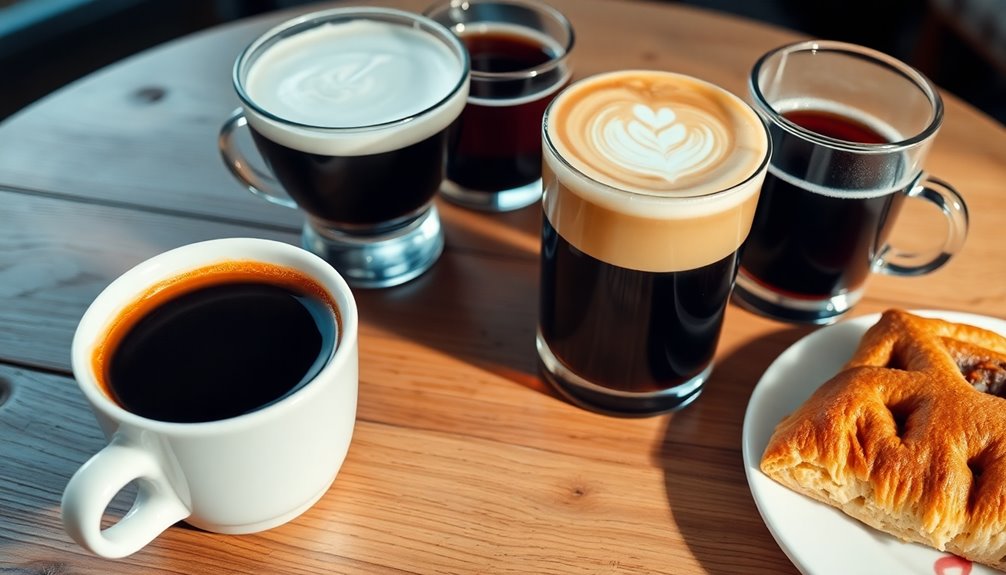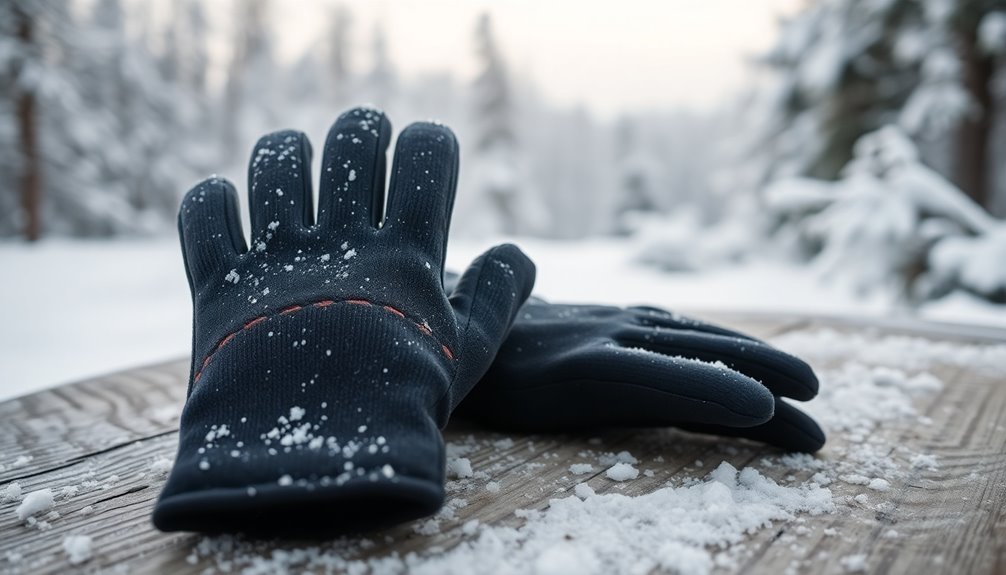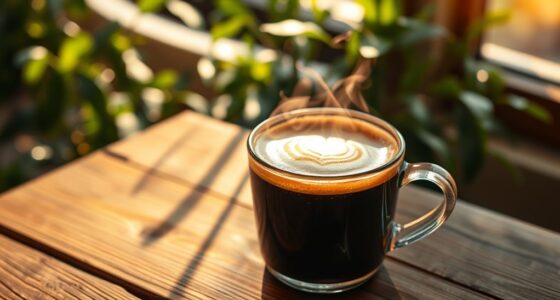In Germany, you’ll find a variety of coffee types that reflect the country’s unique taste. The most popular choice is “einen Kaffee,” a smooth filter coffee. You might enjoy “Milchkaffee,” a creamy blend of coffee and hot milk, or “Schwarzkaffee,” which is a strong black brew. For something stylish, try a “Latte Macchiato” with its appealing layers. Regional specialties like “Kaffee Crème” in the south offer a local twist. With a growing trend in flavored coffees and single-serve machines, there’s a lot to discover. You’ll uncover even more about Germany’s coffee culture as you explore further. As you delve deeper into Germany’s rich coffee landscape, you may also come across interesting influences from around the world, including unique international blends. In contrast, the vibrant and diverse burkina faso coffee flavors provide a different experience with their rich, fruity profiles and distinct acidity. Whether you prefer the familiar comforts of German brews or the adventurous notes of Burkina Faso, there’s always something new to savor in this coffee-loving nation.
Key Takeaways
- Milchkaffee: A creamy blend of filter coffee and hot milk, popular for its smooth texture.
- Schwarzkaffee: Strong black coffee served without milk or sugar, favored for its bold flavor.
- Kaffee mit Milch: Coffee mixed with cold milk, offering a milder taste.
- Latte Macchiato: A stylish drink featuring layers of milk and espresso, appealing to modern coffee drinkers.
- Kaffee Crème: A regional specialty in southern Germany, known for its rich and creamy profile.
German Coffee Culture Overview

When you think about coffee in Germany, you're stepping into a culture that values both flavor and connection. Germans are Europe's largest coffee importers, favoring smooth, low-acid roasts over the more intense varieties.
The most popular style is filter coffee, often simply ordered as "einen Kaffee." You'll find that black coffee is a staple, served throughout the day, and it's common to enjoy it during the cherished tradition of Kaffee und Kuchen, where coffee and cake create a perfect social experience.
Social gatherings, or kaffeeklatsch, highlight the importance of coffee in fostering relationships. Major brands like Tchibo and Jacobs offer a range of options, ensuring that the German coffee culture continues to thrive, blending flavor with community.
Popular Coffee Variations
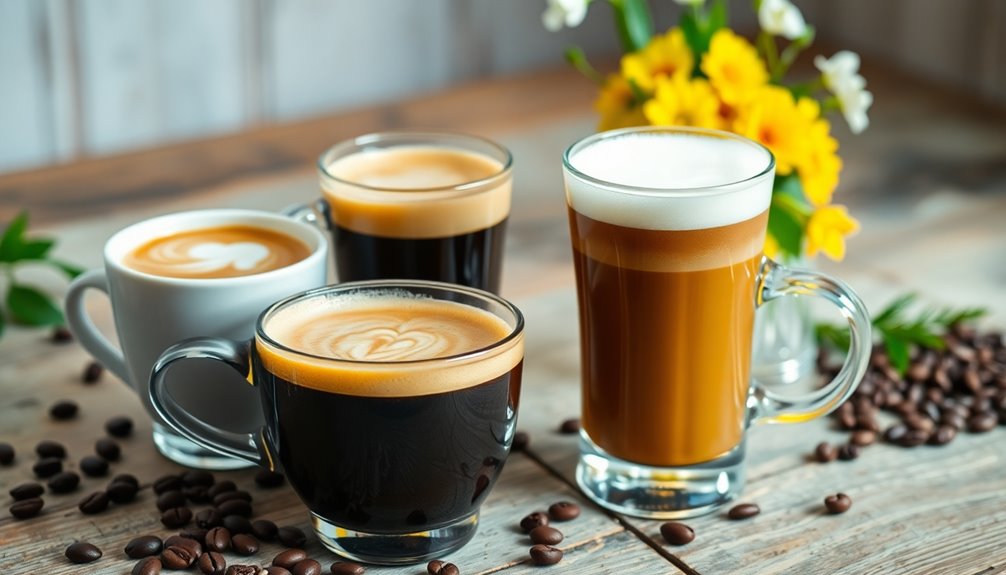
When you explore popular coffee variations in Germany, you'll find a mix of traditional styles and unique regional twists.
From the creamy comfort of Milchkaffee to the strong simplicity of Schwarzkaffee, each option offers something special.
Let's take a closer look at these delightful choices and see what makes them stand out.
Traditional German Coffee Styles
Coffee culture in Germany is rich and diverse, offering a variety of traditional styles that cater to different tastes.
The standard term, Kaffee, usually refers to filter coffee, which is the most popular choice. If you prefer something creamier, try Milchkaffee, a delightful blend of filter coffee and hot milk, often served in a larger cup.
For a bolder flavor, go for Schwarzkaffee, which is simply black coffee without any milk or sugar. You might also enjoy Kaffee mit Milch, where cold milk is added for a smoother texture.
Another modern favorite is Latte Macchiato, served in a tall glass with layers of milk and espresso, giving you a stylish twist on traditional German coffee.
Unique Regional Variations
While exploring the coffee scene in Germany, you'll discover unique regional variations that showcase local preferences and traditions.
One of the most beloved choices is Kaffee mit Milch, a simple coffee enhanced with a splash of cold milk. In contrast, Schwarzkaffee appeals to those who savor the boldness of black coffee, free from milk or sweeteners.
You might also encounter Filterkaffee, a staple in many homes, known for its smooth and balanced flavor from traditional drip brewing.
In urban cafés, the Italian-inspired Latte Macchiato has gained popularity, served in tall glasses with beautiful layers.
Additionally, specialty drinks like Kaffee Crème blend espresso and steamed milk, especially enjoyed in southern Germany and Switzerland.
Each variation reflects the rich tapestry of German coffee culture.
How to Order Coffee

Ordering coffee in Germany is straightforward, and knowing a few key phrases makes it even easier.
If you want to order coffee in German, start with "Einen Kaffee, bitte" for a classic drip coffee. Prefer something creamier? Say "Milchkaffee" for a latte or "Kaffee mit Milch" for coffee with just a splash of milk.
For a robust black coffee, simply ask for "Schwarzkaffee," and if you like it sweet, add "mit Zucker." If you need milk alternatives, request "Mandelmilch," "Sojamilch," or "Hafermilch."
Want to enjoy your drink on the go? Just say, "Einen Kaffee zum Mitnehmen, bitte."
Now, you're all set to sit back and enjoy your Kaffee trinken!
Brewing Methods in Germany

When it comes to brewing methods in Germany, you'll find a strong preference for traditional techniques that highlight a smooth and mild flavor.
Drip brewing with Melitta filters reigns supreme, making filter coffee a staple in many households. This method perfectly captures the mild roast profile that Germans adore.
The French press also enjoys popularity, offering a richer coffee experience while still aligning with the preference for milder flavors.
For convenience, single-cup espresso machines like Tassimo and Keurig are common, allowing you to brew according to your taste.
In cafés, professional coffee machines deliver superior quality, though replicating that at home can be tricky.
Coffee Roast Levels

When you explore coffee roast levels in Germany, you'll notice a strong preference for milder flavors.
Most Germans lean toward medium roasts, which offer a smooth, low-acid profile that's easy on the palate.
While darker roasts like French and Vienna exist, they're harder to find, reflecting the country's overall taste for balanced brews.
German Roast Preferences
While many coffee enthusiasts around the world seek bold and intense flavors, Germany's coffee roast preferences lean towards the milder end of the spectrum. Most German roasts are around 220 °C (City Roast), delivering a smooth, balanced taste. Darker roasts, like Vienna and French, are less common, as the market favors medium roasts low in acidity. This leads many coffee drinkers to enjoy filter coffee, often brewed with traditional drip machines. Brands like Jacobs and Tchibo dominate the coffee market, reflecting these preferences. If you're curious about the types of roasts, here's a quick overview:
| Roast Level | Flavor Profile | Popularity in Germany |
|---|---|---|
| Light Roast | Bright, fruity | Low |
| Medium Roast | Smooth, balanced | High |
| Dark Roast | Bold, intense | Very Low |
Common Brewing Methods
To truly appreciate the milder flavors of German coffee, it's essential to explore the common brewing methods that enhance these characteristics.
In Germany, traditional drip-brew machines using Melitta filters are popular, allowing for consistent brewing of smooth, low-acid coffee. If you prefer a richer flavor, you might enjoy using a French press, which also allows you to experiment with different ground coffee coarseness.
Single-cup espresso machines like Tassimo and Keurig have gained traction, providing convenience while still catering to the preference for milder profiles.
While darker roasts like Vienna and French exist, most Germans stick with medium and light roasts, reflecting their commitment to quality in coffee preparation and the belief that freshly-ground coffee is key to achieving the best flavor.
Flavor Profiles Explained
Understanding the flavor profiles of coffee roast levels is essential for anyone wanting to appreciate the nuances of German coffee.
In Germany, milder flavors are favored, with most roasts landing around 220 °C, resulting in smooth and low-acid varieties.
Here's a quick rundown of typical roast levels:
- Cinnamon/Light Roast: 195 °C, offering a bright, fruity taste.
- City Roast: The most common, balancing flavor and acidity.
- Medium Roast: Popular brands like Jacobs Kronung and Tchibo Feine Milde exemplify this preference.
- Darker Roasts: Less common, often frustrating for enthusiasts seeking bolder flavors.
This inclination towards milder blends reflects an essential aspect of German culture, focusing on smoothness and gentleness in your coffee experience.
Coffee and Cake Tradition

Kaffee und Kuchen, a cherished tradition in Germany, brings friends and family together for a delightful afternoon ritual that dates back to the 17th century. You'll typically enjoy coffee with an array of cakes, creating a warm atmosphere perfect for conversation. Common cake choices include the decadent Black Forest Cake, creamy German cheesecake, and delicious Apfelstrudel.
Here's a quick look at popular options:
| Cake Type | Main Ingredients | Flavor Profile |
|---|---|---|
| Black Forest Cake | Chocolate, cherries | Rich, fruity |
| German Cheesecake | Cream cheese, eggs | Creamy, tangy |
| Apfelstrudel | Apples, cinnamon | Sweet, spiced |
Engaging in Kaffee und Kuchen is also a great way to practice your German language skills!
Regional Coffee Brands
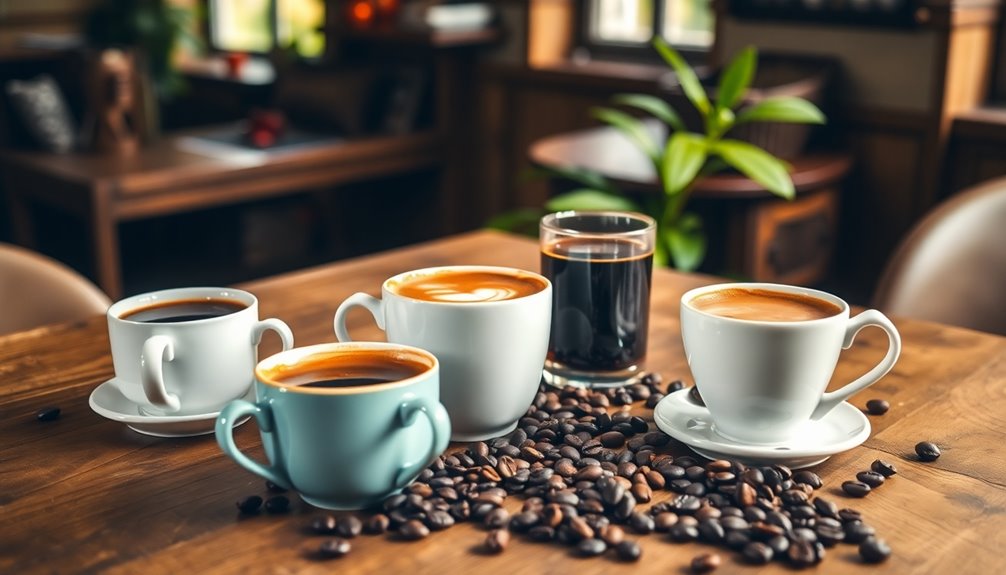
When you think about coffee in Germany, you can't ignore the big names like Dallmayr, Jacobs, and Tchibo.
Each brand brings its own unique flavor profiles and brewing techniques, catering to the diverse tastes of coffee lovers.
Let's explore how these regional brands shape the coffee culture across the country.
Popular German Coffee Brands
Germany's coffee scene boasts a rich variety of popular brands, each offering unique flavors and blends that cater to diverse tastes.
Among the top contenders, you'll find:
- Tchibo: Known for its quality ground and instant coffees like Tchibo Feine Milde.
- Jacobs: Offers smooth options such as Jacobs Kronung and Jacobs Crema Gold.
- Dallmayr: Recognized for premium selections like Dallmayr Naturmild and Dallmayr Crema DOro.
- Der Franz: Specializes in instant coffee and flavored Nespresso capsules.
These brands highlight the concentrated nature of the German coffee market, where six firms dominate around 85% of sales, particularly in Bremen and Hamburg.
With so many options, you're sure to find a favorite that suits your palate!
Regional Flavor Profiles
Coffee lovers will discover that regional brands in Germany showcase distinct flavor profiles shaped by local traditions and preferences.
In northern areas, you'll find milder blends, while southern regions often favor bolder flavors, reflecting historical coffee preferences. Bremen and Hamburg stand out as key coffee import and roasting centers, producing well-known regional brands like Tchibo and Dallmayr, celebrated for their smooth, low-acid offerings.
Brands like Jacobs and Dallmayr highlight unique roasting techniques, delivering balanced flavor profiles milder than the stronger roasts of Italy or France.
Additionally, specialty coffee from Bavaria may incorporate local ingredients, creating unique flavored coffees inspired by regional spices or desserts.
This variety in German coffee truly illustrates the cultural nuances of coffee consumption throughout the country.
Brewing Techniques Employed
Regional brands not only reflect local flavor profiles but also highlight diverse brewing techniques that shape the coffee experience in Germany.
The emphasis on filter coffee is evident, especially with traditional drip-brew machines using Melitta filters, known for their simplicity and smooth results.
Here's a quick look at popular brewing options:
- Mild City Roasts: Brewed around 220 °C for low-acid flavor.
- Tchibo and Jacobs: Offer ground and instant coffee for convenience.
- Espresso Machines: Single-cup systems like Tassimo and Keurig are gaining popularity.
- Specialty Shops: Introduce alternative methods like French press and pour-over.
These brewing techniques cater to a variety of preferences, making your coffee experience uniquely German.
Impact of Coffee on Society

While you might think of coffee as just a morning pick-me-up, it actually plays a significant role in shaping social interactions in Germany.
The tradition of Kaffee und Kuchen encourages friends and families to gather for afternoon breaks, strengthening relationships over shared treats. In fact, coffee is consumed more frequently than water or beer, highlighting its fundamental place in daily life.
The practice of kaffeeklatsch fosters casual meet-ups, creating a sense of community and enhancing social bonds. Many Germans lean towards milder coffee roasts, promoting a culture of mindfulness and appreciation for quality.
Local cafés and bakeries serve as essential spaces for connection, allowing individuals to engage in meaningful conversations and reinforce the social fabric of their communities.
Health Considerations of Coffee
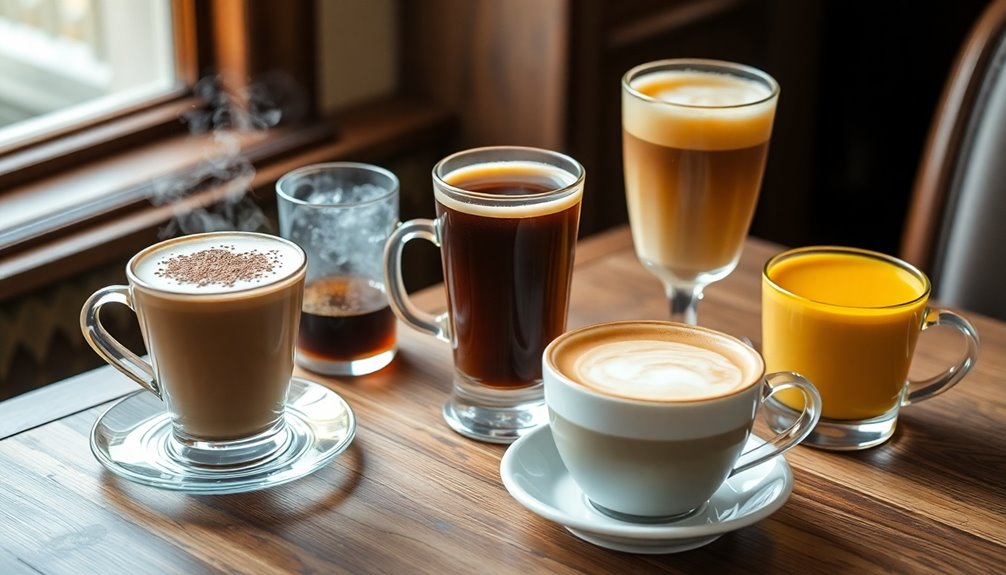
For many in Germany, enjoying coffee isn't just about the taste; it's also about health.
With growing awareness of health factors, many Germans are switching to low-acid coffee varieties that are gentler on their digestive systems. The mild roasting techniques, typically around 220 °C, help produce smoother flavors while reducing the risk of stomach discomfort.
Here are some health benefits of coffee to evaluate:
- May improve cognitive function
- Could lower the risk of certain diseases
- Often available in organic options
- Typically contains fewer additives
Coffee Trends and Innovations

As the coffee culture in Germany evolves, consumers are embracing a variety of trends and innovations that enhance their brewing and tasting experiences.
Specialty coffees, including flavored options like hazelnut and vanilla, are gaining popularity among those seeking diverse coffee tastes. Innovations in brewing, such as single-serve machines like Tassimo and Keurig, make preparing coffee at home more convenient than ever.
Cold brew coffee is also trending, especially among younger drinkers craving invigorating caffeine in warmer months. You'll find plant-based milk alternatives like almond and oat milk in many cafés, catering to health-conscious and vegan consumers.
Plus, coffee subscription services are on the rise, allowing you to explore new brands and blends while enjoying your favorite coffee and cake pairings.
Frequently Asked Questions
What Is the Most Popular Coffee in Germany?
The most popular coffee in Germany is Filterkaffee.
You'll love its smooth, mild flavor, making it a favorite choice throughout the day. Many people enjoy it during breakfast or as an afternoon pick-me-up.
If you want something different, try Milchkaffee, which combines Filterkaffee with hot milk.
For a stronger taste, Schwarzkaffee, or black coffee, is also a great option.
You can't go wrong with these delightful choices when in Germany!
What Is Americano Called in Germany?
When you think of coffee, it's like a warm hug on a chilly day.
In Germany, an Americano is commonly called "Schwarzer Kaffee," which means "black coffee." This term reflects the drink's essence—simple yet satisfying.
If you want to order one, just say, "Einen Americano, bitte," especially in urban cafés where clarity matters.
While filter coffee reigns supreme, many are embracing the Americano for a milder coffee experience.
Enjoy your brew!
How Do You Order Coffee in Germany?
When you order coffee in Germany, start with a polite "Einen Kaffee, bitte" for a regular coffee.
If you want a latte, ask for "Einen Milchkaffee." For black coffee, simply say "Schwarzkaffee."
If you're taking it to go, add "zum Mitnehmen."
Don't forget to specify any preferences, like "Kaffee mit Milch" or alternatives like "Sojamilch" if you prefer non-dairy options.
Clear orders make your coffee experience smoother!
How Is German Coffee Different?
Did you know that Germans consume over 160 liters of coffee per person each year?
German coffee stands out for its milder roast levels, focusing on smooth, low-acid flavors. You'll find filter coffee brewed with Melitta filters, reflecting its historical roots.
When you order, you might choose "Milchkaffee," a delightful blend of coffee and hot milk, or stick with the classic "Schwarzkaffee."
It's all about simplicity and savoring the moment with friends.
Conclusion
As you sip your rich, aromatic cup of German coffee, you can't help but feel the warmth of the cozy café around you. The blend of tradition and modernity dances in each sip, inviting you to explore the vibrant coffee culture. Whether you prefer a velvety cappuccino or a bold filter brew, you're part of a journey that connects people, sparks conversations, and fuels creativity. So, embrace the experience, and let the flavors transport you to Germany's charming coffee scene.
